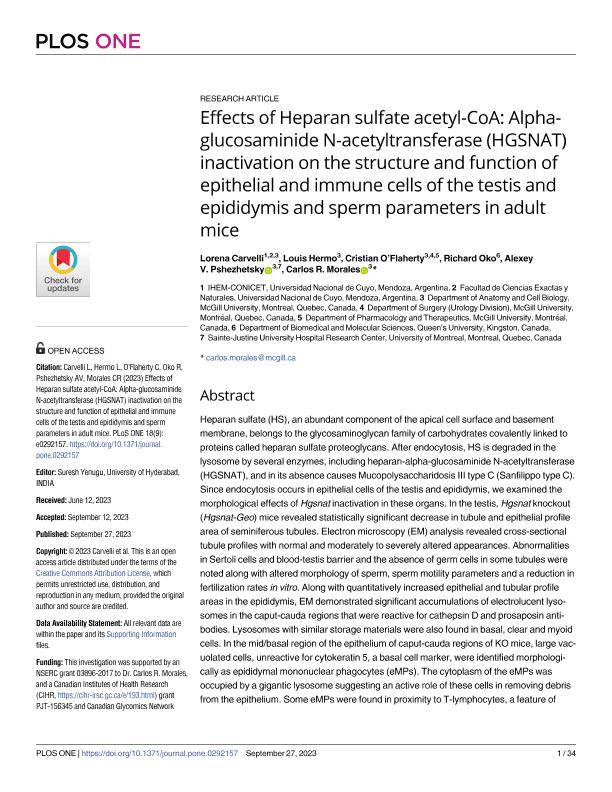Artículo
Effects of Heparan sulfate acetyl-CoA: Alpha-glucosaminide N-acetyltransferase (HGSNAT) inactivation on the structure and function of epithelial and immune cells of the testis and epididymis and sperm parameters in adult mice
Carvelli, Flavia Lorena ; Hermo, Louis; O’Flaherty, Cristian; Oko, Richard; Pshezhetsky, Alexey V.; Morales, Carlos R.
; Hermo, Louis; O’Flaherty, Cristian; Oko, Richard; Pshezhetsky, Alexey V.; Morales, Carlos R.
 ; Hermo, Louis; O’Flaherty, Cristian; Oko, Richard; Pshezhetsky, Alexey V.; Morales, Carlos R.
; Hermo, Louis; O’Flaherty, Cristian; Oko, Richard; Pshezhetsky, Alexey V.; Morales, Carlos R.
Fecha de publicación:
09/2023
Editorial:
Public Library of Science
Revista:
Plos One
ISSN:
1932-6203
Idioma:
Inglés
Tipo de recurso:
Artículo publicado
Clasificación temática:
Resumen
Heparan sulfate (HS), an abundant component of the apical cell surface and basement membrane, belongs to the glycosaminoglycan family of carbohydrates covalently linked to proteins called heparan sulfate proteoglycans. After endocytosis, HS is degraded in the lysosome by several enzymes, including heparan-alpha-glucosaminide N-acetyltransferase (HGSNAT), and in its absence causes Mucopolysaccharidosis III type C (Sanfilippo type C). Since endocytosis occurs in epithelial cells of the testis and epididymis, we examined the morphological effects of Hgsnat inactivation in these organs. In the testis, Hgsnat knockout (Hgsnat-Geo) mice revealed statistically significant decrease in tubule and epithelial profile area of seminiferous tubules. Electron microscopy (EM) analysis revealed cross-sectional tubule profiles with normal and moderately to severely altered appearances. Abnormalities in Sertoli cells and blood-testis barrier and the absence of germ cells in some tubules were noted along with altered morphology of sperm, sperm motility parameters and a reduction in fertilization rates in vitro. Along with quantitatively increased epithelial and tubular profile areas in the epididymis, EM demonstrated significant accumulations of electrolucent lysosomes in the caput-cauda regions that were reactive for cathepsin D and prosaposin antibodies. Lysosomes with similar storage materials were also found in basal, clear and myoid cells. In the mid/basal region of the epithelium of caput-cauda regions of KO mice, large vacuolated cells, unreactive for cytokeratin 5, a basal cell marker, were identified morphologically as epididymal mononuclear phagocytes (eMPs). The cytoplasm of the eMPs was occupied by a gigantic lysosome suggesting an active role of these cells in removing debris from the epithelium. Some eMPs were found in proximity to T-lymphocytes, a feature of dendritic cells. Taken together, our results reveal that upon Hgsnat inactivation, morphological alterations occur to the testis affecting sperm morphology and motility parameters and abnormal lysosomes in epididymal epithelial cells, indicative of a lysosomal storage disease.
Palabras clave:
HGSNAT
,
EPIDIDYMIS
,
SPERM
,
MUCOPOLYSACCHARIDOSIS
Archivos asociados
Licencia
Identificadores
Colecciones
Articulos(IHEM)
Articulos de INST. HISTOLOGIA Y EMBRIOLOGIA DE MEND DR.M.BURGOS
Articulos de INST. HISTOLOGIA Y EMBRIOLOGIA DE MEND DR.M.BURGOS
Citación
Carvelli, Flavia Lorena; Hermo, Louis; O’Flaherty, Cristian; Oko, Richard; Pshezhetsky, Alexey V.; et al.; Effects of Heparan sulfate acetyl-CoA: Alpha-glucosaminide N-acetyltransferase (HGSNAT) inactivation on the structure and function of epithelial and immune cells of the testis and epididymis and sperm parameters in adult mice; Public Library of Science; Plos One; 18; 9-2023; 1-34
Compartir
Altmétricas



